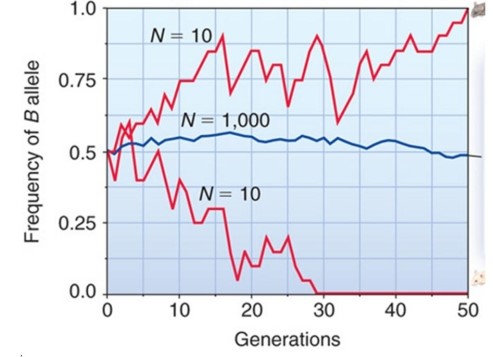The number of generations it takes for an allele to become fixed or lost in a population depends on population size. There are three populations associated with the frequency of the b allele and its change in frequency. Which population(s) show dramatic change in b allele frequency and what are these changes? Population 1 = brown mouse (top line) ; Population 2 = middle line; population 3 = white mouse (bottom line) .

A) Population 1; it shows an extinction of the ballele resulting in all brown mice.
B) Population 3; it shows an extinction of the ballele resulting in all white mice.
C) Population 2; it shows an increase in the frequency of the b allele after 50 generations.
D) Population 1; it shows a fixation of the ballele resulting in all brown mice and Population 3 shows . an extinction of the b allele resulting in all white mice.
E) Population 1, 2, and 3 all show drastic changes in ballele frequency after 50 generations, with the . complete elimination of the b allele in all three populations.
Correct Answer:
Verified
Q19: Cryptic female choice is a type of
Q20: In humans, sickle-cell anemia is caused by
Q21: Why would a female song bird choose
Q22: Male deer have large antlers that are
Q23: Natural selection is one mechanism to change
Q25: Which of the following would most likely
Q26: GGG and GGC are codons for the
Q27: Sickle-cell anemia is a disease that occurred
Q28: Neutral variation is supported by the observation
Q29: Inbreeding increases the likelyhood that an individual
Unlock this Answer For Free Now!
View this answer and more for free by performing one of the following actions

Scan the QR code to install the App and get 2 free unlocks

Unlock quizzes for free by uploading documents